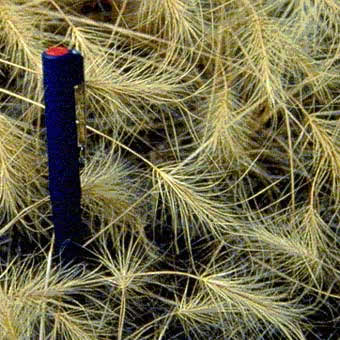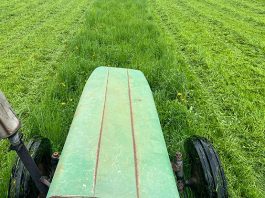Last week we looked at why Medusahead Rye is so dangerous. This week Beth shares how we can prevent its spread. These tips are important for preventing the spread of all kinds of weedy species, so check them out and use them, even if you don’t have Medusahead.

Preventing medusahead from establishing in new areas is far more cost-effective than trying to control it after invasion. A prevention program should include:
1) preventing the introduction of medusahead seed,
2) reducing site susceptibility and
3) establishing a program for early detection and monitoring.
How are medusahead seeds spread?
Medusahead seeds are small, with long awns barbed with silica scales. These seeds easily attach to animals, clothing, vehicles, and machinery. Although most seed remains in, or near, a medusahead infested area, seeds can move much longer distances in a variety of ways.
A study in southeast Oregon showed that medusahead infestations are often concentrated along travel routes, primarily along unimproved roads and secondly along hiking and animal trails. This indicates that cars and trucks, construction equipment, and farm machinery are the primary sources that move medusahead seed into a clean area, but animals and humans also move seed (Davies et al. 2013).

Medusahead seeds can be moved from one area to the next by sticking to the coats of wildlife and livestock. In Utah, new infestations of medusahead are often discovered on south facing slopes, places where deer and elk feed and bed during the winter. Humans also transport seed. Seeds caught in clothing, equipment, pet fur, or mud stuck to a vehicle can move seeds long distances and infest new areas (Davies 2008). Seed-eating small mammals and birds aren’t likely to spread medusahead seed. With the exception of deer mice, most rodents don’t stash medusahead seeds. In addition, most birds do not like medusahead seeds (Longland 1994; Goebel and Berry 1976).
Wind and water can also move medusahead seed. For example, medusahead seed can be moved short distances (typically less than 4 inches) when the seeds get caught on other plants whose main mode of dispersal is wind, including tumble mustard and Russian thistle. In some cases, whole seedheads of mature medusahead plants may break off and tumble with the wind. Seeds can also be dispersed by water if medusahead is growing near riparian areas, though this is unusual.
Preventing spread of medusahead seeds
 Control infestations along roads and trails,
Control infestations along roads and trails,
Controlling medusahead infestations along roads near clean areas should be the highest priority for control. Since infestations more likely to occur along travel routes, vehicles and animals moving on infested roads and trails can easily move seed into new areas (Johnson and Davies 2012).
Reduce site susceptibility.
Disturbing soil or vegetation may help medusahead establish in clean areas. The best way to prevent medusahead from invading a clean site is to maintain a strong stand of competitive vegetation. Perennial grasses compete more effectively with medusahead than forbs or shrubs. Thus, producers should manage for healthy stands of perennial bunchgrasses and seed areas with perennial grasses if necessary. Maintaining a healthy stand of perennials may require changes in grazing management or other practices which favor perennials (Sheley and James 2010).
Prevent overgrazing.
Proper management of livestock grazing can reduce populations of medusahead. Grazing can be managed to maintain desirable vegetation. Overgrazing, especially in spring, can reduce the competitive ability of perennial grasses. Best grazing management for these rangelands is often a rotation system where sites are grazed during the growing season one year, after seed set the next year, and not at all (rest from grazing) in the third year.
Minimize disturbance.
Disturbing the soil such as during construction projects, mechanical brush removal, grading, and so on should be conducted with caution in medusahead-free rangeland. If these activities take place near the edge of a clean area or adjacent to an infested site, medusahead can readily establish in the disturbed soil. If the area disturbed is in a line, such as construction of roads, powerline right-of-ways, or pipelines, it may help medusahead invade a clean site. After projects that disturb the soil are finished, especially projects near the edge of a clean area, the area should be inspected periodically for new infestations.
Plant Protective Buffers.
A medusahead-infested area next to a clean site poses a high risk of invading that site. Creating a protective buffer around an infestation can help protect a clean site. Since most medusahead seeds drop near the plant and don’t self-disperse over greater distances, vegetative buffers can help to contain infestations. In one study, 20-foot wide containment “fences” of desert wheatgrass were established around medusahead infestations. These barriers prevented about 98% of medusahead seed from moving out of infested areas. Such buffers might limit medusahead from invading into ecologically sensitive sites (Davies and Sheley 2007).

Clean, Clean, Clean
Preventing the spread of any noxious weed is always the same. Don’t let anything or anyone on your property that may carry medusahead seeds. Here are some guidelines:
1. Vehicles and equipment used in medusahead infested areas, particularly during summer months when the heads have viable seed, should be cleaned on site before moving to new, uninfested areas.
2. Vehicles entering uninfested areas, especially agricultural, construction, and fire-fighting equipment, should be inspected and cleaned if necessary.
3. Field workers should check their clothing and remove any clinging seeds before leaving the area and/or entering clean sites. Medusahead seeds are most commonly found in shoelaces and shoe eyelets, socks, and pants cuffs.
4. Seed dispersal by livestock can be greatly reduced if livestock are not transported directly from infested sites to clean sites during summer. If transport must be done at this time, holding the animals between sites for a few days will allow most seed attached to their coats to shed. Sites where animals are unloaded from trailers should be inspected periodically for new infestations.
5. When agricultural or construction materials must be brought in to a clean site, these products should be free of medusahead seed. Seed mixes for revegetation and hay for forage, should be certified weed-free. Gravel and fill material for construction should be inspected to ensure they are weed-free, and the sites where such material is used should be inspected periodically for new infestations.
Monitor often, detect early, and take action.
It may not always be possible to prevent medusahead seed from entering a site. However, monitoring the site for new infestations, paying particular attention to those areas at highest risk of invasion, can help to detect a medusahead infestation in its early stages. At this point, medusahead can be eradicated before the plant becomes widespread, crowds out other species, and develops a soil seedbank.
Focus monitoring in areas where medusahead seed is most likely to be introduced including:
1) along roads, trails, and near facilities;
2) areas where livestock are loaded and unloaded;
3) places where gravel or other fills have been introduced;
4) recently disturbed soils;
5) edges of clean sites near infested areas and
6) areas with high scenic or ecological value.
Monitor at times of year when medusahead is easy to see. In spring, medusahead is hard to distinguish from other grasses. Later in the season, when medusahead begins to head out, it is easier to see. Unfortunately, by this time, medusahead may already be producing viable seed. Monitoring is most effective when coupled with rapid-response tactics, e.g., pulling, hoeing, or spot-treating with roundup as soon as plants are found. If seeds appear to have filled, remove, bag, and dispose of the plants. It is also useful to mark the site of the infestation using a GPS unit so the location can be watched closely in future.
Next week we’ll look at a newly discovered method for getting rid of the Medusahead you may already have.
Primary Reference
The majority of the information presented in this fact sheet came from: Kyser GB, JM DiTomaso, KW Davies, JS Davy, and BS Smith. 2014. Medusahead Management Guide for the Western States. University of California, Weed Research and Information Center, Davis. 68 p.
Other References
Davies, KW. 2008. Medusahead dispersal and establishment in sagebrush steppe plant communities. Rangeland Ecology and Management 61:110-115
Davies, KW and RL Sheley. 2007. Influence of neighboring vegetation height on seed dispersal: implications for invasive plant management. Weed Science 55:626-630.
Davies KW, AM Nafus, and MD Madsen. 2013. Medusahead invasion along unimproved roads, animal trails, and random transects. Western North American Naturalist 73:54-5.
Goebel, CJ and G, Berry. 1976. Selectivity of range grass seeds by local birds. Journal of Range Management 29:393-395.
Johnson, DD and KW Davies. 2012. Medusahead management in sagebrush-steppe rangelands: prevention, control, and revegetation. Rangelands 34:32-38.
Longland, WS. 1994. Seed use by desert granivores. Desert Plants 30:233-237.
Sheley, RL and JJ James. 2010. Resistance of Native Plant Functional Groups to Invasion by Medusahead (Taeniatherum caput-medusae). Invasive Plant Science Management 3:294-300.




